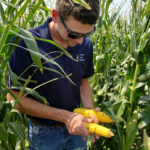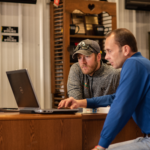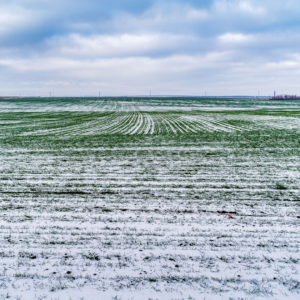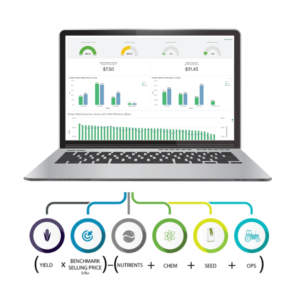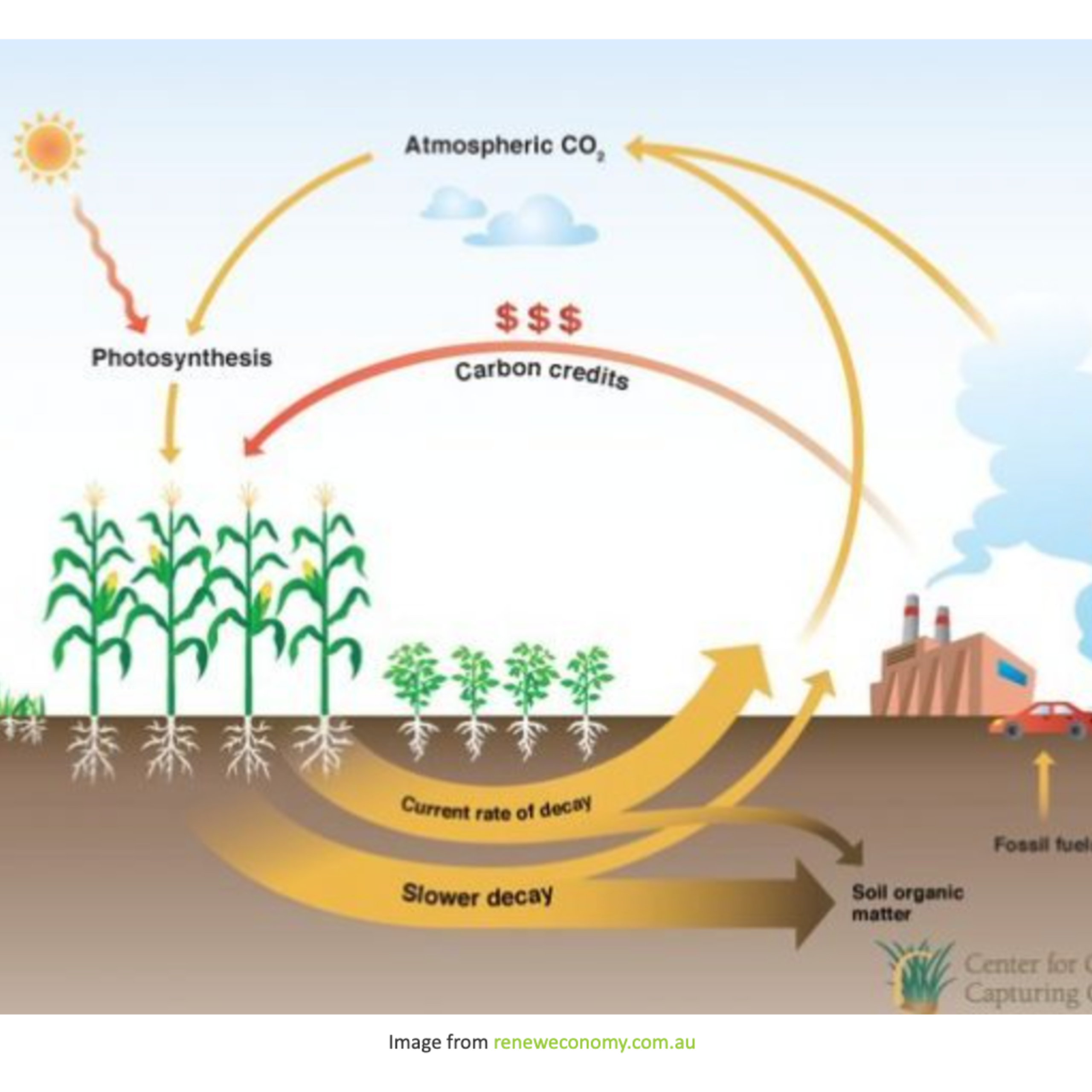
Today we are talking with Dr. Jerry Hatfield on the topic of carbon sequestration. Also on the show are Dan Frieberg and Renee Hansen from Premier Crop.
DAN FRIEBERG: Great to have you with us, Jerry. It couldn’t be more timely to be talking to an expert. There’s just so much buzz right now about carbon credits in agriculture. Could you just give us any perspective you want to share? I know you probably have talked about this for decades. For everybody else, it’s kind of the latest buzz. There’s just a lot of attention to soil carbon or how we can sequester carbon.
JERRY HATFIELD: We kind of have this interesting view of carbon. We have all this carbon in the atmosphere. When people say we’re going to sequester it in the soil, I think they magically think it’s going to go from the atmosphere into the soil and be stored there. But you have to realize that in agriculture, we take carbon dioxide and we combine that with sunlight to create carbohydrates. This is where plant growth comes from. When we put it into the soil, it’s basically because we’ve transported it from the leaves down into the roots. Then we take those root exudates and feed the microbes that put that carbon into the soil.
It is a very active process. It requires that we have a living plant. The only way in which we pump CO2 from the atmosphere is with deep wells. People actually just dump and pump air down into the deep earth. In agriculture, it’s really a very active process. And because it is an active process, we have a combination of sequestration, as well as cycling. A lot of it gets sequestered into soil organic matter. It gets built into those aggregates, but a lot of it is really recycled very, very quickly. We have microbes that chew it up. They put it into aggregates, and then they decompose and it gets recycled.
We have to realize that, in agriculture, we do build it up over time. It’s a very dynamic process and has all these different implications for us in terms of improving our soil structure and nutrient cycling. That really is where the value of carbon is coming from.
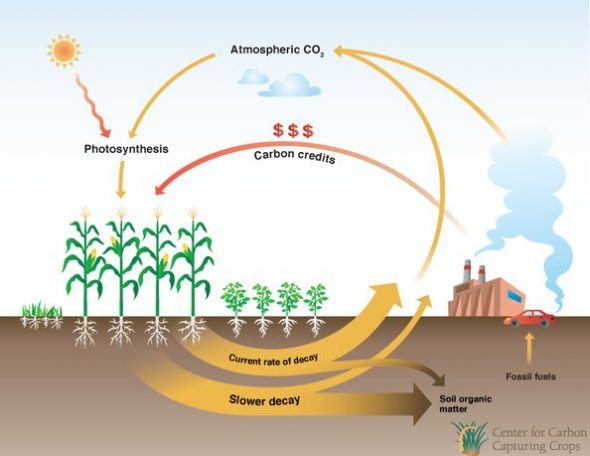 Image from reneweconomy.com.au
Image from reneweconomy.com.au
DAN FRIEBERG: When we till soils, do we expose soil carbon to the atmosphere? It seems like a lot of the attention is obviously around not tilling. What’s the tillage relationship to sequestering carbon?
JERRY HATFIELD: There’s an estimation that about 40% of that organic material is going out of the roots as root exudates, which is basically sugars that are feeding the microbes. Of that, a large percent is going into CO2 that’s trapped in that soil volume. So, when you till, all you’re doing is basically releasing a lot of that CO2 that’s been trapped in there. Then it goes right back to the atmosphere very quickly.
The other part is that when we till, we expose a lot of that soil to the air. The microbes really begin to change that organic material and digest it very quickly, so we see another puff of CO2. We actually have two mechanisms when we till. That immediate release is really just trapped CO2. The longer term is the spring of activity of the biological community that respires, as well.
DAN FRIEBERG: Some extension person was saying that if we no-tilled, if every acre in the world was switched to no-till, we could reverse climate change. That’s obviously a huge advocate for no-till, but it was almost like this single change in practice could change climate. I mean, it’s that impactful.
JERRY HATFIELD: I’m not sure I buy that it’s that impactful, and don’t get me wrong. I think that no-till is part of this, but if we think about no-tilling corn and soybeans across Iowa, we’ve still got a large part of that growing season in which nothing is happening. I mean, we may not be disturbing it, but we’re not feeding that microbe. When we really want to build organic material, we’ve got to capitalize on capturing solar radiation and CO2 and putting it in there.
So, we need that extended crop rotation to be able to really change that. Personally, I don’t believe that no-till by itself is the path. I think it’s one component of the system, but I don’t think it is the panacea, saying that if we kept everything else and all we did is change tillage that we solve climate change. I don’t believe that’s really the case at that point.
DAN FRIEBERG: A lot of growers and advisors are familiar with cover crops from a nutrient perspective. Just having a growing plant to grab nitrate as part of a nutrient strategy in the upper Midwest is a way to make a leaky system less leaky, but what you’re talking about is the additional benefit of cover crops to the soil carbon.
JERRY HATFIELD: From the carbon capture perspective, just think about it this way. If we don’t have a growing crop out there, we’re not capturing sunlight. Just look at Iowa, from the time in which we plant that corn and soybeans in the spring until we harvest them. Then, if you look from last frost to when that corn plant really comes up, and then from maturity until it really freezes in spring, we actually have about a third of the solar radiation that’s available to grow something.
So, a cover crop is really, thinking about it, all we’re doing is using that photosynthetic process to capture a lot of carbon out of the atmosphere. In doing so, we obviously affect the nutrients. We affect the water, but I think we’ve got to start putting it into a much larger perspective of: “What are we doing in terms of the dynamics of carbon, nitrogen, water, all simultaneously?”
 Upper Left: No-till; Lower Left: Cover Crop; Right: Row spacing
Upper Left: No-till; Lower Left: Cover Crop; Right: Row spacing
DAN FRIEBERG: As we talk about this, people go to soil health. I mean, they talk about soil health. The frustration for me, sometimes, is soil health tends to be practice-defined, like what practices do you implement? I know there’s different tests. We’re trying to quantify soil health through a test, but when it comes to soil carbon, I know some of these programs are talking about soil testing as a part of that. They’re obviously talking about more than organic matter. So, there is a soil carbon test, right?
JERRY HATFIELD: We’ve had a soil carbon test. I mean, we look at organic material. You can look at soil organic matter. You can look at particulate organic matter. You’ve got a lot of this soil CO2, which a lot of the tests are based on. It’s basically, I believe, a surrogate for the amount of biological activity we have in the soil because those are respiring organisms that generate CO2. So, you’ve got all of these pieces coming together, and I don’t know. When we talk about soil health, I think we need to stand back a little bit because I think everybody says: “Here’s a soil health test.” Well, what do we want that test for? Because a lot of the components of soil health, I think, need to be much more related to soil function: supplying water, supplying nutrients, supplying support, lack of compaction within that.
I think we need a much more holistic view of what we want our soils to do and not get hung up on saying: “What’s the perfect test?” I think that’s what confused a lot of people. “Oh, what’s the one test that I need to go out and run in my field to determine if I got soil health?” Well, you can look at how well that plant is growing. You could look at water infiltration. You could look at a number of different parameters. Just like in us, when we go to the doctor, he just doesn’t say: “Well, I’m going to look at your left earlobe, and that’s the indicator of health.” You look at all these other things that give us a metric of health. I think it’s the same thing in soil. It’s a suite of practices that give us a direction towards functionality.
The other thing is that not every soil within the field is going to respond the same, just like every human doesn’t respond the same to what we do. Soils are going to respond. If we had a really sandy soil in that field compared to clay soil, and we do the same thing on top of them, we’re going to see different rates of response just because of the parent material that’s there. So, I think we need to get that understanding out there, that it’s a dynamic process. It’s also a process that has a lot of moving parts to it, and there are certain attributes that put us down that path, but there’s also going to be different rates of responses we go on, as well.
DAN FRIEBERG: I suggested one time that yield might be a surrogate for soil health, but it was really me trying to say there are areas of the field that just are so consistently high-yielding. To me, it’s probably how they mineralize nutrients and how they hold water and all that. It’s like some of these really consistent high-yield areas. Something is going on underground that is phenomenal, and it’s just “you’re in, you’re out,” and everything’s working.
JERRY HATFIELD: As we understand more and more about spatial variation within fields, we are seeing parts of that field that are the consistent high-yielding zones of that field. I’m always intrigued by the consistent high-yielding parts of that field that are legacy barnyards, where the cattle lot was. People say: “Why, that was 50 years ago. That was there.” So, what changed in that and all of this? The other part of this is we have consistent low-yielding parts of the field, as well, and I think that we can learn a lot by probably looking at the outliers. Why are those high-yielding spots the way they are? Why are those low-yielding spots the way they are? Then, you’ve got the zone that Bruno Basso and the group at Michigan State have come up with.
We’ve got low-yielding stable zones. You’ve got high-yielding stable zones, and then you have unstable zones that really are dependent upon what the weather is during the growing season. Some years they may be high. Some years they may be low, but I do think that one of the pieces in this, in terms of soil health and these high-yielding parts, is those also tend to be much more stable zones in terms of year to year. They don’t have those big fluctuations, and those low-yielding parts don’t have fluctuations either, but they’re really non-profitable zones. These unstable zones, I mean, they could be 280 bushels one year and 120 the next year, and you go: “What happened besides the weather? What’s in that buffering capacity in soils?”
I think that we need to be back thinking about what triggers that soil to be able to do that because, sometimes, it’s raining basically the same across the field. How do we begin to tease that out? I think a lot of us are trying to figure out some of these dynamics. Is it all biological? Or is it physical? Or is it chemical? In reality, it’s all three of those things coming together, but I think that if we want to move agriculture forward, in terms of efficiency and profitability, that we need to start looking and maybe examining from different viewpoints of the system.
DAN FRIEBERG: Yeah, it’s every geography. As we grow as a company and we get in states we haven’t been in before, we just always know that agronomy is local. There’s not a one-size-fits-all, but north-central Iowa, Jerry, those zones, they flip back and forth a lot. A lot of times, they’re the potholes, so they tend to be low-lying areas. They’re organic matter rich. They’re nutrient rich because, seven years out of 10, they’ve got too much water. So, nutrients have built up, just from lack of crop removal. Then, you get a dry year, and they are off the chart. They have so much organic matter and so much water-holding capacity that they will be the best part of the field in a really dry year. They’re the unstable ones that flip back and forth.
JERRY HATFIELD: Well, and then we get them flipped back and forth. You mentioned the water and everything. You pick it up in the spring, and then you struggle getting a population in that part of the field. Sometimes it gets drowned out, but if we can get that crop to start growing, I mean, it has nutrient-cycling capacity and water-holding capacity that is right off the charts.
DAN FRIEBERG: Jerry, going back to the carbon credit thing, will no-till kind of be a foundation for somebody to get carbon credits?
JERRY HATFIELD: I believe that no-till will be part of that process. I think it’s some of the work that Don Reicosky has done, and Morris showing that it’s basically the amount of tillage that you do. If we’re doing full-width tillage, we have a lot of CO2 going in. You’re doing strip-till. No-till is really pretty small. We’re going to have to have some tillage to magically get that seed and fertilizer into the soil. It’s a matter of the width of that and how we disturb it. In the soil, actually, the biology responds very quickly to a lot of the different things, but I do think that reduced tillage is part of this overall process. We see a lot of impacts when we till in the fall, CO2 being released into the atmosphere, that basically we release as much back as we stored the whole summer.
We basically reset the counter to zero at every fall when we do intensive tillage. So, if we want to build it up, we’ve gotta get that piece out of the system. I think that will become part of it. I think that diversifying crops and getting more carbon from the atmosphere into the soil is another part of that. We could say, well, if it’s no-till, we just go to fallow without any tillage, and I guarantee you we won’t change the carbon any. We won’t release any, but we won’t store any because we need that biological system as part of it.
DAN FRIEBERG: Awesome. Is there any scientific debate about any of this? Is the science pretty locked down, as far as the carbon sequestration in farming systems?
JERRY HATFIELD: There is a great deal of debate, and I don’t think it’s going to go away. Part of this is people see different responses, and part of it’s climate-driven. If you think about that same practice that we have in Iowa and transport it to even southern Missouri, all we do is change the climate, and we won’t see near the response because we’ve had a temperature change. We have a lot more respiration going on and warmer soil temperatures. We have a different rainfall pattern, so we see all these different pieces. That’s one piece that adds variation to it, and then a lot of this goes back to these zones within fields.
We see different responses. We need to recognize that there are different soils instead of looking at the field average and saying: “What are those different pieces, and how are they responding?” Then the argument is over. “Are you accruing carbon in the upper six inches of the soil, in terms of that magic plow layer? Are you putting it down deep?” Then, what form of carbon are we measuring? Are we measuring soil organic matter?
A lot of this is in this particulate organic matter. It gets cycled very quickly, that a lot of people don’t measure. I think the scientific debate is going to continue along this path. We’re eventually going to settle in and say: “Here are some of the attributes around this, and let’s look at these attributes and not get hung up on saying that I use a red machine or a green machine to plant our crop.”
I would think that’s where a lot of this gets in, and the same thing in terms of measurements. Did you make this measurement? Did you make that measurement? I often tell producers. They ask what the perfect soil health test is. I say: “If you want to know if you’ve got soil health, just go out and look after your field after a two-inch heavy rain because if you can’t get two inches of rain into the soil, you don’t have soil health.” You’ve got all the aggregates that are stable. You’ve got infiltration going on, and everything else, and they go: “Well, yeah.” It’s kind of an aggregation of lots of different things that is there. It gets them to thinking about what they’re really looking at out there. Same thing in terms of yield that you mentioned.
When we improve our soil health, we see a lot more efficiency of nutrient supply and water supply late in that growing season. We see that plant maintain its green leaf area longer in the grain-filling period. I think there are things that we could get producers interested in just looking at. Asking the question, “What are some of the indications going on that you’re making a change in your system?”
DAN FRIEBERG: Do you see carbon credits as potentially a way to help pay and make the economics even for switching to cover crops and less tillage?
JERRY HATFIELD: If we can get the value of carbon credits up enough. I mean, I was just looking at some data the other day that were really good systems, maybe half to eight-tenths of a ton of this. If we’re only offering $15 a ton, that’s $12. It costs you $30 to put in a cover crop, so you’re still on the negative side of that, even though you can get the value over time. I think we’ve got to give back to producers.
Again, back to your zoning question of saying, how do you really begin to look at profitability across the field, and saying, how do I look at increasing profitability in those poor parts of the field? Is that reducing fertilizer applications because you’re not getting return on doing other things? You could trade that input of fertilizers for the cover crop to be able to improve those.
I think we need a different strategy about how we go about implementing conservation practices across the field. Or, accounting for the value of them and the potential impact, short-term and long-term. I think that therein lies some of the imagination that I think we ought to be using relative to farming systems. We tend to look at our conservation practices as kind of a generic sort of suite. We’ll just lay these on the field out there. But in reality, I think we need to be much more structured in thinking about how they’re going to work. Also how they could be implemented in much more of a dynamic way.
RENEE HANSEN: If a farmer is really skeptical of the whole carbon sequestration, what does he have to do? And is it going to benefit him?
JERRY HATFIELD: If you look at carbon from a benefit perspective, I don’t think we’ve talked enough about the benefits of carbon. We talk about carbon relative to carbon markets. We talk about sequestration but the value of putting carbon back into the soil. I often use this analogy, that if you get into carbon for the carbon market perspective, it’s like new running board money for your pickup. But if you get into improving carbon for the agronomic and efficiency piece, it’s new pickup money.
That’s the orders of magnitude that we’re talking about because we see that improvement in yield stability. We take those low-yielding parts of the field out. I don’t think we’ve explained to producers the real value of carbon and why that’s so critical as part of the field, in terms of nutrient cycling, water infiltration and storage, even overall vigor of the crop.
I think when we put those metrics around it, producers begin to see that these real changes are out there. Often we just sell it from the standpoint of carbon sequestration. It’s going to do good for the climate. But for the producer, they don’t care a whole lot about that. We must put it into that perspective of what it means for them. Then I think it becomes an important part of their decision process as well as an educational effort.
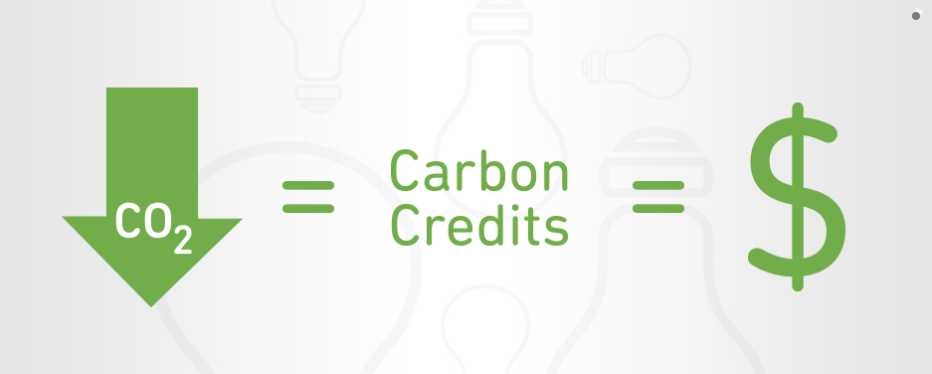
RENEE HANSEN: Absolutely. I think that the value just hasn’t been seen or believed by them yet to understand. There’s so much talk about carbon credits that they’re questioning, “Is this for real? What do I need to do?” It’s just another payment back to the grower. What do they have to do to get it, and what do they have to do to achieve it?
JERRY HATFIELD: We need to realize that there are a suite of practices. Just don’t say, well, as we’ve talked about that, the only way you can get there is no-till. That’s one component. Reduced tillage is one component of the system, crop diversity and putting more crop longer through the growing season there. Even adding bio-based fertilizers, manures, compost, things like this, do a major impact on this. Ultimately, we’re talking about allowing the biological system within the soil to do its thing. Capturing carbon and putting it into soil aggregates and organic matter.
This is a very complex problem that we need to look at. You’re going to see the same result if you did the same thing. I think we need to think a lot more judiciously about how we go about achieving our goals and looking at how practices and pieces and responses fit together. I think that’s part of that whole maturity of really evaluating our system and figuring out where we want to go and how we want to get there.
DAN FRIEBERG: Jerry, in order to change soil carbon, what’s a realistic timeframe? This is a long term. In the relative, it’s not something that changes very fast, right?
JERRY HATFIELD: Well, we actually see changes in carbon within one growing season. Now, measurement-wise, it gets a little difficult to pick that up, but we can see it because of changes in color. We can see changes in aggregates near the surface. Those are kind of the unstable parts of this. The stable parts are really much more in that two-to-five year timeframe. We really want to see depth changes. With depth, we’re talking about plus-10, and I think we’ve got to realize this, but things occur quickly. I was looking at some of the dynamics on root exudates relative to microbial activity, and those often occur within minutes of changing this.
So, you look at all this, and I think we’ve got to realize that we’re dealing in a set of different time constants all the way across our platform. It goes back to the thing on soil health. What parameters are really changing within that? Because we know some parameters are going to change a lot more quickly than others. We see aggregate changes within a growing season. They’re not very stable, but they are changing. So, it’s a matter of what’s that time cost to get it to be much more of a stable aggregate?
RENEE HANSEN: Yeah, so if a grower wants to start implementing some of these, there’s nothing set in stone right now, of what management practices they should follow?
JERRY HATFIELD: No. We talk about why there’s so much controversy within the science community. It’s that there’s not a common set of practices. A lot of people have not accounted for the fact of all the weather variation that occurred during their experiment. Sometimes, it’s the rainfall patterns that we talked about with the heavier soils. We get these wet springs, and then we get dry summers. That really influences the response. Sometimes, we get dry springs, but we get wet summers. I think that part of this is we’ve got to figure out how to start normalizing a lot of the different characteristics that are out there, and even in terms of cover crops.
So, if you run a monoculture cover crop of rye, how large was that rye crop? People say: “Oh, I planted a rye cover crop.” Well, was it 3000 pounds of biomass? Or was it 500 pounds? Just because you had a cover crop doesn’t mean you all had the same efficacy. If you’ve got a cover crop cocktail with a small grain and a legume and a brassica mixture, what was the real biomass that was generated out of that? So, I think there needs to be a lot of normalization of, instead of just saying we did this, what was the real efficacy?
Just going back to Dan’s comment in terms of yield, we need to look at the productivity of our cover crop system over time, and we have tools to be able to do that. I think that starts putting us on much more of an equal footing of saying: “Why do we see these responses across different places?” Well, it could be because we had different levels of input across that we didn’t even characterize.
RENEE HANSEN: So, overall, when it comes to carbon sequestration, does it pay for the farmer? Should they start doing it today?
JERRY HATFIELD: I think it does. I think it pays in lots of different ways. We start this path towards carbon sequestration. We change our infiltration rates. Let’s just start about: “What are we really trying to do in our agriculture across the Midwest?” It’s that we want to take as much precipitation and put it back through that crop to create yield. When we’ve got a soil that’s pretty fragile. We have low infiltration rates of less than a half-inch per hour. When we can just improve the infiltration rate up to two inches per hour, then we get a lot more rain into that system. If I can get rain into the soil, I can store it. If I can’t get it into the soil, it’s just runoff.
We start with realizing that our whole goal in agriculture is to do two things. One is to capture sunlight, and one is to put as much water through that plant as possible. If we get our soil set up so that we’re doing those things, it’s going to pay dividends to us. Then, you’ll end up saying: “Well, I’ll recycle more nutrients. I’ll do all these other things to kind of buffer against the weather variation that’s going on out there.” That’s the path that I think we need to be explaining to producers. What carbon really is doing at various steps along the way.
I believe that if we really want soils to be that carbon sequestering part, we need to be explaining to agriculture and producers. This includes the whole dynamic of carbon and how it’s going to benefit them in ways they haven’t thought about much.
Dr. Jerry Hatfield Bio:
Dr. Jerry Hatfield received his Ph.D. from Iowa State University in 1975 in the area of Agricultural Climatology, M.S. in Agronomy from the University of Kentucky in 1972 and a B.S. in Agronomy from Kansas State University in 1971. He is the retired director of the USDA-ARS National Laboratory for Agriculture and the Environment in Ames, Iowa. Dr. Hatfield worked in California at the University of California, Davis from 1975 to 1983 as a bio-meteorologist working in a range of different crops.
He joined USDA-ARS in 1983 at the Plant Stress and Water Conservation unit in Lubbock, Texas, where he stayed until his transfer to Ames to develop the research program of the National Soil Tilth Laboratory. His research focused on the interactions among the components of the soil plant atmosphere continuum and our linkage to air, water and soil quality. His focus has been on the evaluation of farming systems and their response to water and nitrogen interactions across soils and remote sensing methods to qualify field variation. A platform for his research utilizes the “genetics times environment times management” concept as a framework to work with producers to demonstrate how they can increase their production efficiency, increase soil health and develop resilience to weather and climate variation as the foundation for food security.
His outreach efforts have included participation in the National Climate Assessment as the lead author for agriculture for the U.S. and on the IPCC effort on greenhouse gases and climate change. Dr. Hatfield is an accomplished author with 498 referred publications and eight monographs. He serves as the editor for numerous publications, and he also ranks in the top 2% of researchers in the world. His numerous awards include being inducted into the USDA-ARS Hall of Fame for his research impact and the Hugh Hammond Bennett Award, along with being a Fellow in the American Society of Agronomy, Crop Science Society of America and Soil Science Society of America, and serving as President of the American Society of Agronomy in 2007. Please welcome Dr. Jerry Hatfield.
___________________________________________________________________________________________
- For more helpful tips and insight on all things data and agriculture, visit our blog at http://info.premiercrop.com/blog
- Curious about precision ag? Download our 5 Steps to Getting Started Guide: http://info.premiercrop.com/5-steps-guide
- Ready to cut through the bull? Download our No Bull Guide to Precision Ag: http://info.premiercrop.com/field-profitability-guide
- Podcast provided by Premier Crop Systems. Learn more about us at https://www.premiercrop.com

